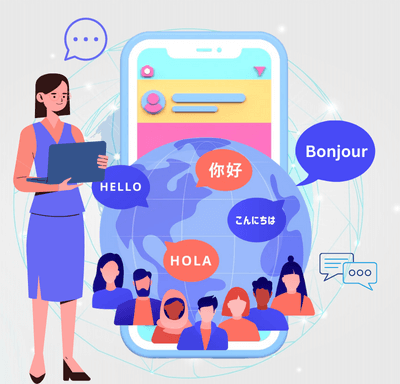
About us
Our Services
Our Expertise
Our Experience
Follow us
Why e2logy?
- We strive to provide superior customer service and ensure that every client is completely satisfied with our work.
- Our engineers are trustworthy, dedicated, and experienced and will go the extra mile to solve your IT issues.
- We are committed to delivering outstanding, cutting-edge IT solutions that add real value that goes beyond what is expected.

The Complete Guide to Mobile App Localization

Localizing apps also involves changing the currencies, dates, times, and number formats used in mobile apps and web content. It is, however, critical not to overlook the fact that there are specific problems associated with application localization. In addition to misaligned texts, missing regional elements, gibberish text strings, and improper use of characters and emojis, other issues have also been identified. The user experience can be significantly affected by this.
Localization of apps is considered an extremely vital aspect of marketing that is pivotal to the success of a brand. Globalization has become an even greater factor for businesses looking to increase their customer base. This is because technological advancements allow mobile devices to reach more and more people around the world.
What is mobile app localization?
The development of mobile apps for international markets, languages, and cultures is known as localization. You need to translate more than just your app’s interface and page. Using dates, times, and numbers in the regional format would help connect your app with users in their playing fields.
Why mobile app localization?
The importance of localizing your apps can’t be overstated. We’ve explained what it is, but there’s no doubt that it’s important. A few specific reasons will be discussed below.
Boost the downloads of your app
It is possible to increase your app’s downloads if you translate it into other languages. Increasing numbers of people use mobile devices in their native languages, and the global market for mobile apps is growing rapidly. This growing international audience can be reached by localizing your app into multiple languages.
Providing a better user experience globally
Although 90% of mobile device activity occurs within apps and not in browsers, we need to ask why most users download apps and then delete them after a few minutes. Mobile app localization holds the key to the answer. Translating and localizing your mobile app to your international users’ native language and culture will provide them with a seamless mobile experience.
Provide better customer service
To improve customer service, companies need to understand the cultural differences between countries and offer different support options accordingly. In other words, a person who calls from another country may quickly become frustrated if they don’t understand the accent of the person who is speaking to them.
Increase revenue
Your visibility in international markets and exposure to app stores are important if you want to become the leading choice in your market. It’s beneficial to localize your app so that it can run on various operating systems, devices, and platforms, which will help it to rank higher in search results. More revenue can be generated through higher rankings and positive reviews. You can ensure your app’s success by making it as accessible as possible.
An Overview of Localization Strategies for Mobile Apps
Successful localization begins with careful planning, just like any other major upgrade.
Rather than developing substandard localizations in a hundred markets, it often pays to master a few key markets rather than rush into every major market.
It is thus imperative that you identify your target markets before developing your localization strategy.
Identify your target markets
If you are considering app localization, the first question is “Which languages do you want to target? You don’t have to expand to every market just because localization gives you access to a global audience. Time and money are both involved in localizing an app to a new locale. Therefore, you need to make sure that you maximize your return on investment by making the right decision.
If you’re considering expanding to another country or region, you need to do market research. Your app should be localized for those respective languages or locales based on that analysis. You might think it makes sense to target the United Kingdom, Brazil, and Germany with a sports app if your target market is soccer fans. Using this method, you will be able to make your app accessible in en_US, en_UK, pt_BR, and de_DE locales.
Create a mobile app
The preparation of the mobile application includes many details, including layout and space. Aside from these aspects, we also pay attention to:
Interface: Observing that what works in one country may not work in another is the key to understanding what is attractive in one country. There are preferences in every culture.
Servers: To avoid delays and interruptions, we need to check and decide whether working with local servers is the best option.
The design: It is important for our experts to select fonts, colors, images, and graphics that are easy to adapt to the local culture. It is also important to ensure the client’s source content is ready for multi-language use, and that the app code allows them to easily and cost-effectively create language versions of their products.
Take a look at your existing users
Consider your current user base when conducting your research.
You can use analytics to discover where your existing users are located and what languages they prefer. The localization of an application will be most successful in locales that have a high share of user traffic.
Users’ feedback can provide a lot of useful information besides raw data. Reviewers who mention accessibility or ask for a language-specific version of your app should be watched. There may be signs that aren’t directly obvious; the location of the reviews and feedback may be important.
Take a look at your competitors
Analyzing competitors is another essential method of finding keywords for your foreign language app.
Learn the titles, subtitles, and descriptions of your rivals’ apps. Your app localization can be even more successful if you use keywords that drive traffic to other similar apps. Make sure you check other elements of the app page as well. To help local users better understand their products, these apps redesign their art assets, color palettes, and call-to-actions.
Take a step beyond translation
Besides translating your app’s text into another language, localization involves taking cultural differences into account, such as the way names and dates are written differently in different countries. Aside from currency symbols and units of measurement (kilometres vs miles), other factors must also be taken into account.
Analyzing the market
The results of market research can be used in conjunction with your stats and feedback to identify which audiences are likely to be most profitable.
Many helpful metrics can be found on sites like Sensor Tower and App Annie. For example, App Annie research indicates that smartphone users spent an average of four hours on mobile apps each day in nine markets in Q1 2021. In addition to providing insight into various types of apps, these platforms also provide specific insights.
You can also gain some insight into your direction by studying your competitors. Following the leading brand’s lead might be worthwhile if they have localized.
Optimization strategy for app stores
Here’s how to make the mobile app both search engine friendly and appealing to smartphone users. Considering that a higher app ranking increases the likelihood that users will download it, our typical strategy is as follows:
- Our team of experts researches relevant keywords for titles, subtitles, and app descriptions, then optimizes them based on those keywords.
- A special focus will be placed on improving the app’s logo as part of our work on the visuals of the mobile app.
- As opposed to using original app photos, our experts always use the ones from the localized version. A preview video for the mobile app will also increase downloads, as they have some resources to do so.
Testing for localization is essential
The localization test should be conducted on a variety of devices with different screen sizes based on what is commonly used in the region in question.
To ensure that the app is internationalized before starting any localization process, specialists recommend performing a “pseudo-localization test”.
Your business will grow beyond national and linguistic boundaries once you transform a successful local app into a successful global app.
Final Words
This guide to app localization is intended to assist you in localizing your app. It is important for your app to be accessible to as many people as possible, since its potential is worldwide. The process of translating an app into another language is not as straightforward as you might think. Professional translators can provide quality translations for you if you want to achieve optimal results.
E2logy specializes in localizing mobile apps and knows everything there is to know about translating mobile apps so that they reach the vastest audience possible. If you need help with app localization, feel free to contact us-you won’t be disappointed.













